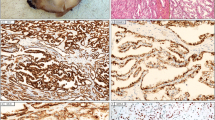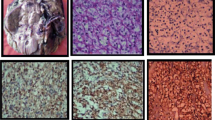Abstract
Renal cell carcinoma (RCC) in which clear cells with papillary architecture are present is a difficult diagnostic challenge. The most common type, clear cell RCC, only rarely has papillary architecture. The second most common one, papillary RCC, only rarely contains clear cells. However, two recently described less-common types, clear cell papillary and Xp11 translocation RCC characteristically feature both papillary architecture and cells with clear cytoplasm. Accurate diagnosis has both prognostic and therapeutic implications. This study aims to highlight the helpful cytomorphologic and immunohistochemical features of each of these entities to enable reproducible classification. Sixty RCC cases with clear cells and papillary architecture were selected and classified according to The International Society of Urological Pathology (ISUP) Vancouver Classification of Renal Neoplasia and graded according to The International Society of Urological Pathology (ISUP) grading system for renal cell carcinoma then stained for CK7, carbonic anhydrase IX (CA IX), α-methylacyl-CoA-racemase (AMACR) and TFE-3. The characteristic immunoprofile of Clear RCC is CK7-, AMACR-, CA IX+ and TFE3-, papillary RCC is CK7+, AMACR+, CAIX- and TFE3-, while for clear cell papillary RCC it is CK7+, AMACR-, CAIX+ and TFE3- and lastly Xp11translocation RCC is CK7-, AMACR+, CAIX- and TFE3+. Immunohistochemical staining for CA IX, CK7, AMACR and TFE3 comprises a concise panel for distinguishing RCC with papillary and clear pattern.




Similar content being viewed by others
References
Deng F, Melamed J (2012) Histologic variants of renal cell carcinoma: does tumor type influence outcome? Urol Clin N Am 39:119–132
Zhanyong B, Priti L, Song L et al (2013) Role of carbonic anhydrase IX, α-methylacyl coenzyme a racemase, cytokeratin 7, and galectin-3 in the evaluation of renal neoplasms: a tissue microarray immunohistochemical study. Ann Diagn Pathol 17:58–62
Sean R, John N, Liang C et al (2013) Clear cell papillary renal cell carcinoma: differential diagnosis and extended immunohistochemical profile. Mod Pathol 26:697–708
Hillary R, Guido M, Pedram A (2012) Renal cell carcinoma with clear cell and papillary features. Arch Pathol Lab Med 136:391–399
Walter B, Hartmann A, Hofstädter F et al (2012) Immunohistochemical marker panel differentiates between the three most common subtypes of renal cell carcinoma independent from histomorphologic criteria. Virchows Arch 460:343–352
Borislav A, Cinthia B (2014) Clear cell papillary renal cell carcinoma: incidence, morphological features, immunohistochemical profile, and biologic behavior: a single institution study. Pathol Res Pract 210:234–241
Rajen G, Elizabeth G, Ximing J et al (2013) Differential diagnosis of renal tumors with clear cytoplasm: clinical relevance of renal tumor subclassification in the era of targeted therapies and personalized medicine. Arch Pathol Lab Med 137:467–480
Park J, Lee C, Suh J et al (2012) Clear cell papillary renal cell carcinoma: a report of 15 cases including three cases of concurrent other-type renal cell carcinomas. Korean J Pathol 46:541–547
Saba K, Özden T, Sümer B et al (2008) Diagnostic utility of cytokeratins 7, 10 and 20 in renal cell carcinoma and oncocytoma. Turk J Pathol 24:140–146
Michelle P, Amy Z, Zhanyong B (2013) Useful immunohistochemical panel for differentiating clear cell papillary renal cell carcinoma from its mimics. Ann Diagn Pathol 17:437–440
Elizabeth M, Musie G, Robert N et al (2010) Carbonic anhydrase IX expression in renal neoplasms: correlation with tumor type and grade. Am J Clin Pathol 134:873–879
John RS, Brett D, John NE et al (2013) The International Society of Urological Pathology (ISUP) Vancouver classification of renal neoplasia. Am J Surg Pathol 37:1209–1220
Brett D, John CC, Guido M et al (2013) The International Society of Urological Pathology (ISUP) grading system for renal cell carcinoma and other prognostic parameters. Am J Surg Pathol 37(10):1490–1504
Edge S, Byrd D, Compton C et al (eds) (2010) AJCC cancer staging manual, 7th edn. Springer, New York, pp 479–489
Stephen M, Yonghong X, Yupu L et al (2011) Clear-cell papillary renal cell carcinoma: molecular and immunohistochemical analysis with emphasis on the von Hippel–Lindau gene and hypoxia-inducible factor pathway-related proteins. Mod Pathol 24:1207–1220
Brannon A, Haake S, Hacker K et al (2012) Meta-analysis of clear cell renal cell carcinoma gene expression defines a variant subgroup and identifies gender influences on tumor biology. Eur Urol 61:258–268
Aydin H, Chen L, Cheng L et al (2010) Clear cell tubulopapillary renal cell carcinoma: a study of 36 distinctive low-grade epithelial tumors of the kidney. Am J Surg Pathol 34:608–1621
Duan L, Youseff R, Margulis V et al (2011) Clear cell papillary renal cell carcinoma: clinicopathologic, immunohistochemical, and molecular analysis. Mod Pathol 24:189–193
Brunelli M, Menestrina F, Segala D et al (2009) Renal cell carcinoma with prominent leiomyomatous proliferation appears not to be a variant of clear cell renal cell carcinoma. Mod Pathol 22:160–165
Shen S, Truong L, Scarpelli M et al (2012) Role of immunohistochemistry in diagnosing renal neoplasms: when is it really useful? Arch Pathol Lab Med 136:410–417
Al-Ahmadie H, Alden D et al (2011) Role of immunohistochemistry in the evaluation of needle core biopsies in adult renal cortical tumors: an ex vivo study. Am J Surg Pathol 36:949–961
Tickoo S, Reuter V (2011) Differential diagnosis of renal tumors with papillary architecture. Adv Anat Pathol 18:120–131
Conflict of Interest
The author declares that there is no conflict of interest.
Author information
Authors and Affiliations
Corresponding author
Rights and permissions
About this article
Cite this article
Alshenawy, H.A. Immunohistochemical Panel for Differentiating Renal Cell Carcinoma with Clear and Papillary Features. Pathol. Oncol. Res. 21, 893–899 (2015). https://doi.org/10.1007/s12253-015-9898-7
Received:
Accepted:
Published:
Issue Date:
DOI: https://doi.org/10.1007/s12253-015-9898-7




